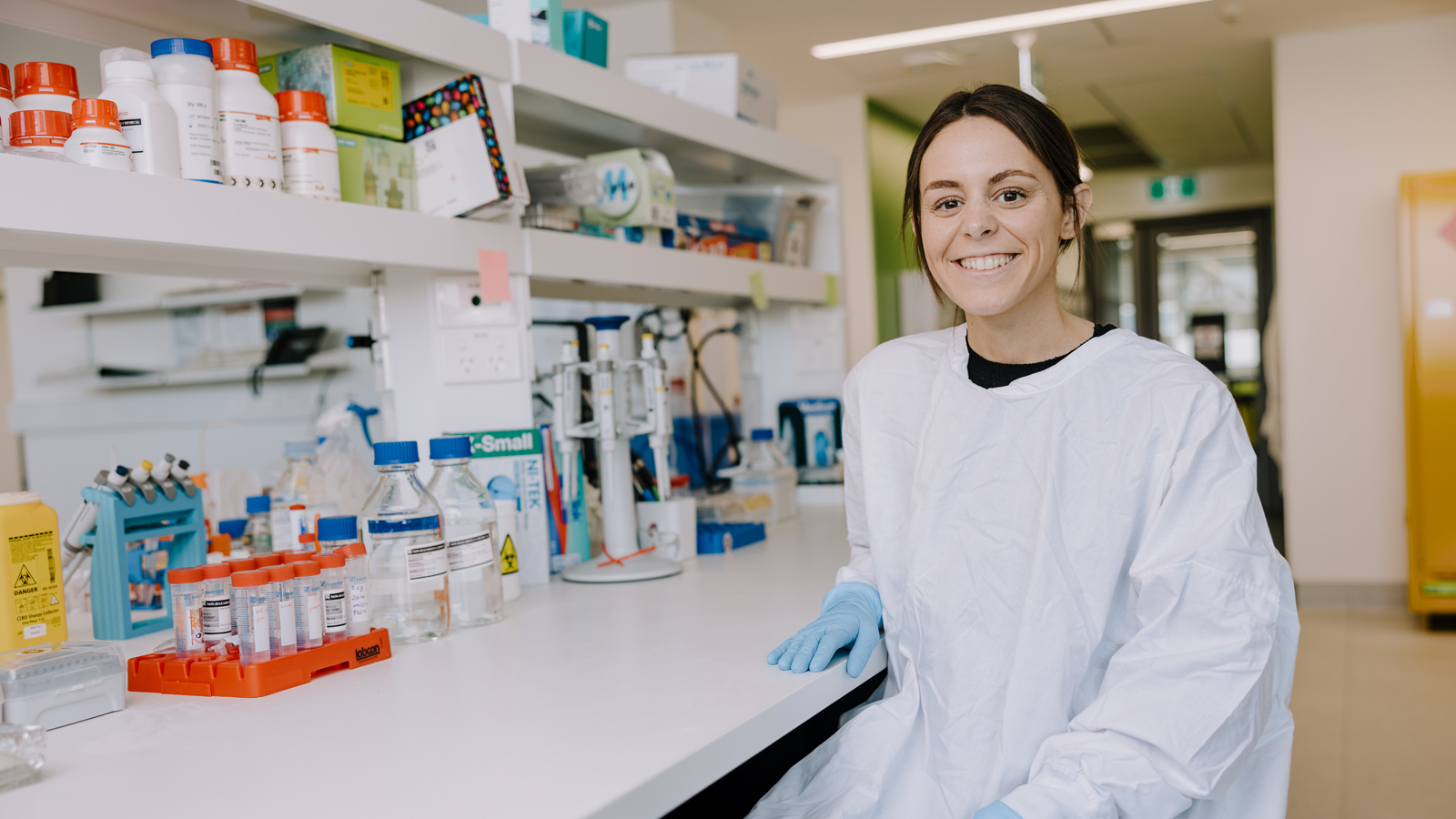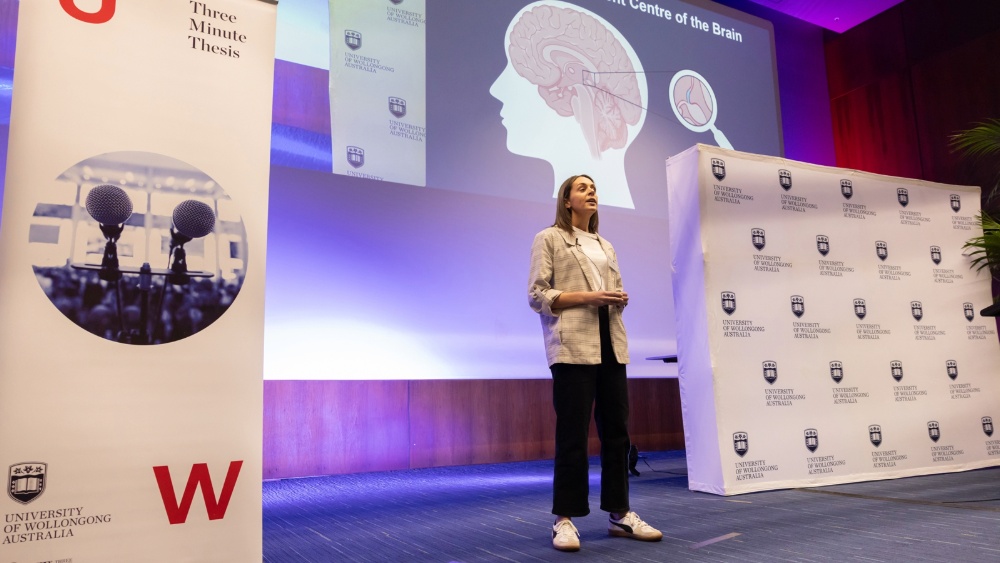Differences in male and female brains could change how we treat depression
Postmortem studies are making the molecular case for targeted mental health treatments
October 1, 2025
Almost half of all people will develop a mental health disorder in their lifetime. The wide range of causes and experiences of these conditions highlights the need for deeper understandings of the biology and how it should be treated.
*Please note: This story includes discussion of mental illness and suicide.
In any given year, 22% of Australians will experience a mental illness such as anxiety or depression, according to the . Despite their prevalence, there is still so much to learn about these conditions and how best to treat them.
51²è¹Ý (UOW) researchers in the School of Medical, Indigenous and Health Sciences are working to understand molecular changes in the brain in psychiatric disorders in an effort to improve treatments. The research led by , Associate Research Fellow and PhD candidate Sarah Cameron, recommends more targeted approaches that align with the breadth of different ways that individuals experience conditions including depression, bipolar disorder and schizophrenia.

The not-so-lucky serendipity of antidepressants
While people with mild depression might feel relief from psychotherapy or lifestyle changes alone, those with moderate or severe depression often require the help of antidepressant medication.
There are many antidepressants on the market, however, studies show , and many experience negative side effects. Little is known about why these medications work for some people and not for others, so a trial-and-error approach is usually taken. This can be an expensive, time consuming and stressful process for individuals who are already suffering and can put pressure on our health system.
“What we have currently is this really general treatment approach to psychiatric disorders,” says Dr Walpole. “It was almost serendipity that we discovered some of the treatments we use today.”
This comes down to how little is known about what is happening in the brain of someone with a mental health disorder. For a long time, it was thought that depression was caused by an imbalance of certain neurotransmitters, such as serotonin and norepinephrine in the brain. Based on this, the frontline treatment for depression is currently selective serotonin reuptake inhibitors (SSRIs) and serotonin-norepinephrine reuptake inhibitors (SNRIs), which are .
“SSRIs and SNRIs can increase the levels of those neurotransmitters within a couple of hours of taking those tablets,” explains Sarah Cameron. “But people with depression generally don’t experience symptom relief, if they experience any, for weeks down the line. This is showing that the therapeutic effect of these drugs isn’t that initial spike in neurotransmitters, but likely a downstream consequence of having those neurotransmitters so high for so long.”
Researchers are hoping to discover where that downstream impact is happening in the brain, acknowledging that the answer is likely to differ greatly across the population.
As there are several types of depression – or other mental health disorders that feature similar depressive symptoms – and everyone experiences it differently, researchers believe there could be a variety of changes happening in the brain.
“If you had 10 people with depression in a room, it is likely all of them would be experiencing it differently,” says Dr Walpole. “We need to know what’s happening in the brain and then from that we can design treatments that are more effective.”

Sarah Cameron is conducting one of the first ever postmortem brain studies on the habenula.
Getting to know the disappointment centre
In her PhD, Sarah is examining a tiny brain region called the habenula in one of the first ever studies to look at it in the postmortem human brain.
“Many people may be aware that our brains have a reward centre,” she says. “If you do something good, your reward centre goes off, you get a prize or a hit of dopamine – which is important for drive and motivation – giving you a good feeling, and you want to do that thing again.
“There is also an anti-reward or disappointment centre: the habenula. If you do something that has a negative impact, and you get punished or hurt, the habenula inhibits dopamine, which encourages you not to repeat that behaviour.”
The habenula’s connection to suggests it may influence multiple aspects of depression, although its anatomically tiny size has previously prevented in-depth analysis. In the last decade, advancements have led to examining how the brain region is dysregulated in depression, through rodent models and neuroimaging studies.
“What they’ve shown is that in individuals with depression, this disappointment centre seems to be overactive, leaving them prone to negative emotions and negative emotional states,” says Sarah.
In exploring how these findings translate to the human brain, Sarah’s postmortem research has shown dysfunction of the habenula in ways that potentially hadn’t been considered.
“In the brain, we have excitatory and inhibitory cells,” she explains. “In an overactive habenula, we’re seeing the excitatory cells taking over, which we expected, but we’re also seeing that the inhibitory cells aren't doing their job of balancing the excitatory signals.”
Sarah is also investigating whether the habenula is dysregulated in other psychiatric disorders.
“Currently, my main study is quite broad and exploratory,” she says. “Because the habenula hadn't been looked at really at all in humans, postmortem, on the molecular level.”
This means she is comparing control specimens with individuals with depression, bipolar disorder and schizophrenia, as well as comparing male and female cohorts, to first establish initial differences between these broad groups.
Though her research is ongoing, Sarah is interested to see if she finds sex-based differences in the habenula, to correlate with preclinical research in which while male mice displayed more inhibitory inputs.

On the basis of sex
“We know that ,” says Dr Walpole. “That's a clue that there's something different happening between the sexes, but it hasn’t been a focus.”
In addition to their own lab-based research, Dr Walpole and Sarah are currently collaborating on a literature review of 1700 postmortem brain studies that have looked at psychiatric disorders and whether they’ve included a balance of males and females, and if they’ve considered sex in their analysis.
“What we’re seeing is that, in the past, researchers would either not look at sex at all, or they look at it as something to control, removing the influence of sex or any impact it could have on their data in their analysis,” says Sarah.
The danger of ignoring sex is three-fold: limiting the ability to deepen understandings of the complexities of these disorders, the potential overlooking of effective treatment avenues, and the risk of prescribing not just ineffective but dangerous treatments to certain individuals.
In her PhD, Dr Walpole examined , which impacts our emotions.
“There was no change in males with depression compared to those without, but females with depression did have these significant differences,” she says, clarifying that she’s referring to biological sex, as gender identity information isn’t available in postmortem studies. “In a situation like this, a one-size-fits-all treatment could be detrimental. If you were to target the kynurenine pathway in males, you might make something worse because there was nothing wrong to begin with, whereas you might improve symptoms in females.
“If you’re looking at data where a factor has decreased for males and increased for females, but you’re considering them all as one group, together they net zero and you could find no change, when there’s actually a significant finding.”
Although not in the scope of their review of postmortem studies, the impacts of neglecting sex in preclinical and clinical studies are clear.
“Historically, researchers wouldn’t use female rodent models because it’s too hard to control for their equivalent of the menstrual cycle,” says Sarah. “But that’s what the clinical population has so it needs to be investigated.”
, Dr Walpole and Professor Newell discuss preclinical studies targeting the kynurenine pathway as an antidepressant treatment. These treatments were only assessed in male rodent models, yet research suggests they may be more effective in females.
While kynurenine-based treatments for major depression are progressing to clinical trials, this does call into question whether other approaches that could have been beneficial in females have been discounted as not viable in these early stages.
“Things are changing, but there is lots more to be done,” says Sarah.
“When you get to clinical trials, you do have both sexes being included,” says Dr Walpole. “But if they're not specifically checking how the drug works in females compared to males, they're potentially missing some of the nuance in the results.”

Exploring all avenues
Of course, not all investigations are showing sex-based differences, nor is biological sex the only differentiator or subgrouping that is being explored.
Sarah refers to her current research as a starting point for teasing out other subpopulations and avenues for treatment, while Dr Walpole also found significant changes in the kynurenine pathway that were , seeing a similar pathology in people that died by suicide.
The pair are also interested in the similarities that connect people with depression, bipolar disorder and schizophrenia. Due to a large overlap of symptoms and the wide variety of experiences, these multifaceted and interrelated disorders are frequently misdiagnosed, which can delay appropriate treatment.
“Some people with bipolar disorder predominantly cycle through depression,” says Sarah. “A large component of schizophrenia is the psychosis, but it also has cognitive and depressive symptoms.”
“Part of our research is focusing more on a symptom and the biology of that symptom,” says Dr Walpole. “Psychosis can happen in depression, bipolar and schizophrenia. Is there a pathway in the brain that causes psychosis specifically? If we can treat the psychosis, that's relevant to all these disorders.”
While there’s a long way to go to completely move away from the current trial-and-error treatment approach, an increased understanding of the biology of different subgroups will increase the likelihood of a treatment being effective and reduce instances of overprescribing ineffective medications.
“If someone has inflammation in the brain, let's address the inflammation,” says Dr Walpole. “But if they don't have inflammation, no, we're not going to give them that kind of treatment. The less medication we can use the better.”
“Improving treatments doesn’t necessarily mean pharmacologically,” adds Sarah, highlighting evidence behind light therapy, nutrition, exercise and psychotherapy, and the potential to understand which people might respond best to these interventions.
UOW researchers are working to improve understanding of psychiatric disorders more broadly. While public awareness and understandings of depression and anxiety have improved significantly in recent years, conditions such as bipolar disorder and schizophrenia are still largely stigmatised.
“We’re trying to show that there is this biological basis to these disorders,” says Dr Walpole. “No one is choosing to have these disorders; there is a core, underlying biology which we are hoping to understand better.”
“This is something that is still poorly understood,” says Sarah. “There's definitely so much to learn and so much progress to be made.”
If this story has raised concerns for you, please remember support is available. UOW has a range of free support services for staff and students. You can also call on 13 11 14 or on 1300 22 4636 for confidential support anytime.